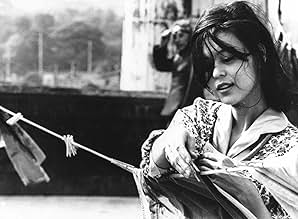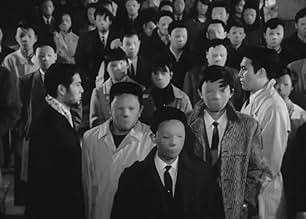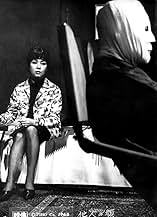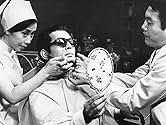CALIFICACIÓN DE IMDb
7.9/10
11 k
TU CALIFICACIÓN
Un hombre de negocios con el rostro desfigurado obtiene una máscara realista de su médico, pero la máscara comienza a alterar su personalidad.Un hombre de negocios con el rostro desfigurado obtiene una máscara realista de su médico, pero la máscara comienza a alterar su personalidad.Un hombre de negocios con el rostro desfigurado obtiene una máscara realista de su médico, pero la máscara comienza a alterar su personalidad.
- Premios
- 2 premios ganados en total
Robert Dunham
- Foreign man in Bar
- (sin créditos)
Opiniones destacadas
I loved the premise, appreciated the philosophy, and enjoyed some of the avant-garde bits of filmmaking here, but I don't think this film quite lived up to its full potential, and it didn't fully connect with me.
From the start, there are existential themes of isolation and absurdity, and the man's condition reminded me of Gregor Samsa waking up and discovering he was a giant bug. With his face heavily bandaged, he's alienated from everyone around him, including his wife, who shrinks from his touch. The film explores identity, acceptance, and whether the mask or persona we adopt liberates or controls us. The minor parallel story of the young woman with the scar on her face also deals with a mask of sorts, and isolation.
Existentialism was common after WWII, and perhaps heightened in Japan by its having lost the war, and gone through more dramatic changes politically and psychologically. Maybe the young woman in the minor story, with burns apparently suffered in childhood at Nagasaki, is a symbol for the country's scars, and its identity fundamentally changing. Similarly, maybe the man losing his face from an accident at work is a symbol for the modern or corporate world changing us, as we work as cogs in a machine.
I loved to think about those things, but the film doesn't expand on them as profoundly as it could have. Instead of a character arc that shows some form of change in the man over time, it gives us mostly dialogue which doesn't land as philosophically as I think it was intended, and commits the sin of telling us instead of showing us in the process. The doctor gives us dire warnings about far more changes than we actually see. Having the man's primary focus be to seduce his wife while disguised in his new mask was unimaginative and uninspired, though I did like thinking about the irony of this being the opposite of love, which should involve an unmasking and getting to one another's 'true self.' There are also banal bits like women putting on make-up being yet another form of mask. As for the parallel story, with the incest, rising sun, and oblivion, I think there is symbolism and some level of desperation or despair here, but it's not strong, and narratively it probably should have been at least loosely integrated with the main story.
Overall though, the film is well worth seeing. The production value is high, with that ultra-cool doctor's office, and the assortment of creative visual tricks director Hiroshi Teshigahara gives us, including freeze frames and surreal imagery. The striking scene in the crowd towards the end is also fantastic, and the film's best. My favorite line to ponder was this one: "I wonder if we see the true face of a gem when it's polished, or in the rough."
From the start, there are existential themes of isolation and absurdity, and the man's condition reminded me of Gregor Samsa waking up and discovering he was a giant bug. With his face heavily bandaged, he's alienated from everyone around him, including his wife, who shrinks from his touch. The film explores identity, acceptance, and whether the mask or persona we adopt liberates or controls us. The minor parallel story of the young woman with the scar on her face also deals with a mask of sorts, and isolation.
Existentialism was common after WWII, and perhaps heightened in Japan by its having lost the war, and gone through more dramatic changes politically and psychologically. Maybe the young woman in the minor story, with burns apparently suffered in childhood at Nagasaki, is a symbol for the country's scars, and its identity fundamentally changing. Similarly, maybe the man losing his face from an accident at work is a symbol for the modern or corporate world changing us, as we work as cogs in a machine.
I loved to think about those things, but the film doesn't expand on them as profoundly as it could have. Instead of a character arc that shows some form of change in the man over time, it gives us mostly dialogue which doesn't land as philosophically as I think it was intended, and commits the sin of telling us instead of showing us in the process. The doctor gives us dire warnings about far more changes than we actually see. Having the man's primary focus be to seduce his wife while disguised in his new mask was unimaginative and uninspired, though I did like thinking about the irony of this being the opposite of love, which should involve an unmasking and getting to one another's 'true self.' There are also banal bits like women putting on make-up being yet another form of mask. As for the parallel story, with the incest, rising sun, and oblivion, I think there is symbolism and some level of desperation or despair here, but it's not strong, and narratively it probably should have been at least loosely integrated with the main story.
Overall though, the film is well worth seeing. The production value is high, with that ultra-cool doctor's office, and the assortment of creative visual tricks director Hiroshi Teshigahara gives us, including freeze frames and surreal imagery. The striking scene in the crowd towards the end is also fantastic, and the film's best. My favorite line to ponder was this one: "I wonder if we see the true face of a gem when it's polished, or in the rough."
After an industrial accident that leaves his face disfigured for life, Mr. Okuyama (Tatsuya Nakadai)begins to question the meaning of life and his own identity, should he keep working, will his disgusted wife ever sleep with him again. His psychotherapist offers him the chance to avail of an illegal medical practice that he has invented, it's a mask moulded from the face of another, that Okuyama can wear to live life a little more normally. The mask gives him a new lease of life, but his therapist warns him that the mask could take over and influence him to do evil things. As the mask takes control Okuyama can't resist but to give in to his baser instincts, his main plan being, to seduce own wife, that he believes may be cheating on him anyway. With thematic echoes of Franju's Les Yeux sans visage and even Delmer Daves Dark Passage, Teshigahara delivers his expressionistic adaptation of Kôbô Abe's novel with style, the results being a dark and epic tale that will haunt its viewers. Its full of inventive visuals and clever tricks with sound, which along with Tôru Takemitsu's superb score contribute wonderfully to the theme of how fragile identity really is and how the masks we all wear hide our true beings and souls. There's also a secondary story of an unnamed facially deformed girl, who is also struggling to cope with her disfigurements and her tragedy is equally moving.
movie about self perception and the bond between the mind and the body...soundtrak really set the mood for the increasing horror in the story line. Nakadai downplays his role to give an overall flawless performance. Watch for some really good lines which will undoubtedly force the viewer to start thinking right away which may distract from the plot (but hey, it's an artsy masterpiece right?)...There is a lot of experimentation in the cinematography such as a door which opens and reveals a cluster of hair in ocean tides...this effect serves to foreshadow the action but may in the view of modern audiences comes across as trying TOO hard to be an art film. I left the movie still trying to link the two parallel story lines in the film and you may too...but don't worry you get two stories for the price of one...DO NOT watch this movie in the dark even though there is nothing VISUALLY terrifying it is still a great horror film...
Mr. Okuyama (Tatsuya Nakadai) is a physically and emotionally wounded man. After an industrial accident at work, his face has been scarred and mutilated beyond recognition, and even his wife rejects him, even though she says his physical appearance doesn't matter. It has left him bitter and angry, until his psychiatrist Dr. Hira (Mikijiro Hira) comes up with a way to fashion a 'face mask' that will give him the appearance of having a completely normal face, albeit with a few joining marks. Hira doesn't do this just out of kindness, he is fascinated how this new face will alter Okuyama's personality and way of life.
The Face of Another is a fascinating film that highlights the social attitudes to physical appearance. There are hundreds of films and morality tales that teach you that it is inner beauty that counts, and once you allow this to shine then your physical attractiveness becomes irrelevant. Everyone knows that this is bullshit, so its refreshing to see a film that makes it clear from the outset that physical appearance has a massive part to play in society. Okuyama's new face, which is an attractive one, changes him so much that he takes on an almost dual identity. Dr. Hira delights in telling him that he has bought flashy new clothes, something he was never concerned with before. It becomes clear that whilst before Okuyama merely wanted to be normal again and fit back in society, his new face is engulfing him, and to be 'normal' simply isn't enough anymore.
As with many of the Japanese New Wave film-makers of the 1960's-70's, director Hiroshi Teshigahara takes some bold steps and sneaks in some surrealist and art-house values in a movie that is otherwise played relatively straight. A 'fictional' character appears every now and then throughout (she is first imagined by Okuyama's wife as a character in a movie); one side of her face is scarred and burned. She appears quite rarely, but seems to serve as an alternative to Okuyama's increasingly vain soul. Another scene seems a ball of hair that floats in the air, unnoticed by the people in the laboratory. I have no idea what it meant, and couldn't really admit to it being wholly successful, but it certainly got my attention nonetheless.
A powerful, disturbing, and poignant drama/horror from the greatest era in Japanese cinema. The film seems all the more important now, 45 years on, in a world where a botox injection can be as easy as buying a pack of cigarettes, and where physical 'beauty' is less a bonus than a necessity.
www.the-wrath-of-blog.blogspot.com
The Face of Another is a fascinating film that highlights the social attitudes to physical appearance. There are hundreds of films and morality tales that teach you that it is inner beauty that counts, and once you allow this to shine then your physical attractiveness becomes irrelevant. Everyone knows that this is bullshit, so its refreshing to see a film that makes it clear from the outset that physical appearance has a massive part to play in society. Okuyama's new face, which is an attractive one, changes him so much that he takes on an almost dual identity. Dr. Hira delights in telling him that he has bought flashy new clothes, something he was never concerned with before. It becomes clear that whilst before Okuyama merely wanted to be normal again and fit back in society, his new face is engulfing him, and to be 'normal' simply isn't enough anymore.
As with many of the Japanese New Wave film-makers of the 1960's-70's, director Hiroshi Teshigahara takes some bold steps and sneaks in some surrealist and art-house values in a movie that is otherwise played relatively straight. A 'fictional' character appears every now and then throughout (she is first imagined by Okuyama's wife as a character in a movie); one side of her face is scarred and burned. She appears quite rarely, but seems to serve as an alternative to Okuyama's increasingly vain soul. Another scene seems a ball of hair that floats in the air, unnoticed by the people in the laboratory. I have no idea what it meant, and couldn't really admit to it being wholly successful, but it certainly got my attention nonetheless.
A powerful, disturbing, and poignant drama/horror from the greatest era in Japanese cinema. The film seems all the more important now, 45 years on, in a world where a botox injection can be as easy as buying a pack of cigarettes, and where physical 'beauty' is less a bonus than a necessity.
www.the-wrath-of-blog.blogspot.com
Okuyama is an engineer whose face was horribly mutilated in a workplace accident. Feeling shunned by society and rejected by his wife, he shamefully hides his disfigurement behind layers of bandages. After consultation, a psychiatrist offers to make Okuyama a realistic prosthetic mask, to return some semblance of normality to his life. Okuyama accepts, despite the shrink's warning that the mask may alter his personality. Meanwhile, a similarly disfigured young nurse from Nagasaki travels to a seaside resort with her brother, where the depth of her disaffection with the uncaring world around her makes itself known in shocking and unexpected ways.
Based on Kobo Abe's novel of the same name, Hiroshi Teshigahara's 'The Face of Another' is a dark, intriguing drama examining notions of identity, appearance and personality, and how the three intersect. Abe's screenplay tackles these themes- as well as that of cultural identity- maturely and with great tact, while also retaining much narrative tension. In fact, if one wished to disregard the psychological and sociological aspects of the story entirely- interpreting the film simply as a horror with a lot of wordy dialogue- one could; and the impact of 'The Face of Another' wouldn't be much diminished.
It is a rewarding experience, however, postulating on the psychological questions raised by Abe's narrative, specifically whether or not one's personality is influenced by one's looks, and the extent to which one's looks informs one's quality of life. It is commonly accepted that physical appearance does have a meaningful impact on people's life experiences and opportunities. Researchers like Daniel Hamermesh posit that the traditionally handsome and beautiful generally have an easier time of things than their less attractive counterparts. At the same time, according to the theory of facultative personality calibration, personalities develop in a way that match other genetic traits, so that one who is more handsome will be more assertive or confident, and vice versa.
'The Face of Another' provokes contemplation around- and plays into- these ideas, as well as examining how Japanese cultural identity was irrevocably altered following WWII and the devastation of Nagasaki and Hiroshima. Okuyama's loss of face and adoption of the mask suggests that one's face is not just a physical feature, but a means of communication with society and oneself. By losing this means of communication, Okuyama loses his connection to his original culture and sense of self. So too did the destruction of Nagasaki and Hiroshima alter the face of Japanese society, ensuring that post-war Japan was- in some ways- indistinguishable from pre-war Japan. In this regard, the film suggests that identity- both personal and cultural- is fluid, and heavily influenced by external factors.
The film inspires rumination around these notions, whilst stunning with its visuals. Hiroshi Segawa's cinematography and shot construction is striking and strange, heightening the eerie tone of proceedings. His work, heavy in visual metaphor, lends sequences- such as a breath-taking, multi-masked crowd scene- an odd but undeniable power. Utilizing a wide variety of stylizations- including bizarre zooms, x-rays and jump cuts- he keeps things feeling consistently fresh, innovative and off kilter. This is only compounded by Arata Isozaki and Masao Yamazaki's surrealist art direction, as well as Yoshi Sugihara's assured, experimental editing, which holds everything together masterfully.
One would be remiss not to discuss the score from Toru Takemitsu, which fluctuates between the macabre and the mournful, while always remaining melodic. The main theme- entitled The Waltz- is particularly atmospheric and haunting, reflecting through it's bittersweet melody Okuyama's fragile psychological state. Furthermore, Taichiro Akiyama's sterling efforts crafting all the masks must be mentioned, as there are a great many throughout the picture and each one is spectacularly insidious.
'The Face of Another' boasts a fine cast of actors all doing superlative work. Tatsuya Nakadai stars as Okuyama, bringing both sides of the fellow to life most efficaciously. Suppressing his characteristic charisma, he lays bare the crisis of personality Okuyama faces, creating a most memorable character in the process. Alongside him, Miki Irie showcases a great emotional perspicuity in her role as the disfigured nurse, stealing all the scenes she's in. Additionally, Mikijiro Hira consistently impresses as the psychiatrist and Machiko Kyo delivers a remarkably understated performance as Okuyama's wife- it's a pity she didn't have more screen time to further develop the character.
A sad film in some regards, a tense one in others; Hiroshi Teshigahara's adaptation of Kobo Abe's novel 'The Face of Another' has a lot to offer viewers. Featuring beautiful black and white cinematography from Hiroshi Segawa and a stirring score from Toru Takemitsu- as well as spellbinding art direction and tight editing- there is very little fault one can find with the picture. Powerfully acted and deftly directed throughout, 'The Face of Another' is a macabre, melancholic masterpiece.
Based on Kobo Abe's novel of the same name, Hiroshi Teshigahara's 'The Face of Another' is a dark, intriguing drama examining notions of identity, appearance and personality, and how the three intersect. Abe's screenplay tackles these themes- as well as that of cultural identity- maturely and with great tact, while also retaining much narrative tension. In fact, if one wished to disregard the psychological and sociological aspects of the story entirely- interpreting the film simply as a horror with a lot of wordy dialogue- one could; and the impact of 'The Face of Another' wouldn't be much diminished.
It is a rewarding experience, however, postulating on the psychological questions raised by Abe's narrative, specifically whether or not one's personality is influenced by one's looks, and the extent to which one's looks informs one's quality of life. It is commonly accepted that physical appearance does have a meaningful impact on people's life experiences and opportunities. Researchers like Daniel Hamermesh posit that the traditionally handsome and beautiful generally have an easier time of things than their less attractive counterparts. At the same time, according to the theory of facultative personality calibration, personalities develop in a way that match other genetic traits, so that one who is more handsome will be more assertive or confident, and vice versa.
'The Face of Another' provokes contemplation around- and plays into- these ideas, as well as examining how Japanese cultural identity was irrevocably altered following WWII and the devastation of Nagasaki and Hiroshima. Okuyama's loss of face and adoption of the mask suggests that one's face is not just a physical feature, but a means of communication with society and oneself. By losing this means of communication, Okuyama loses his connection to his original culture and sense of self. So too did the destruction of Nagasaki and Hiroshima alter the face of Japanese society, ensuring that post-war Japan was- in some ways- indistinguishable from pre-war Japan. In this regard, the film suggests that identity- both personal and cultural- is fluid, and heavily influenced by external factors.
The film inspires rumination around these notions, whilst stunning with its visuals. Hiroshi Segawa's cinematography and shot construction is striking and strange, heightening the eerie tone of proceedings. His work, heavy in visual metaphor, lends sequences- such as a breath-taking, multi-masked crowd scene- an odd but undeniable power. Utilizing a wide variety of stylizations- including bizarre zooms, x-rays and jump cuts- he keeps things feeling consistently fresh, innovative and off kilter. This is only compounded by Arata Isozaki and Masao Yamazaki's surrealist art direction, as well as Yoshi Sugihara's assured, experimental editing, which holds everything together masterfully.
One would be remiss not to discuss the score from Toru Takemitsu, which fluctuates between the macabre and the mournful, while always remaining melodic. The main theme- entitled The Waltz- is particularly atmospheric and haunting, reflecting through it's bittersweet melody Okuyama's fragile psychological state. Furthermore, Taichiro Akiyama's sterling efforts crafting all the masks must be mentioned, as there are a great many throughout the picture and each one is spectacularly insidious.
'The Face of Another' boasts a fine cast of actors all doing superlative work. Tatsuya Nakadai stars as Okuyama, bringing both sides of the fellow to life most efficaciously. Suppressing his characteristic charisma, he lays bare the crisis of personality Okuyama faces, creating a most memorable character in the process. Alongside him, Miki Irie showcases a great emotional perspicuity in her role as the disfigured nurse, stealing all the scenes she's in. Additionally, Mikijiro Hira consistently impresses as the psychiatrist and Machiko Kyo delivers a remarkably understated performance as Okuyama's wife- it's a pity she didn't have more screen time to further develop the character.
A sad film in some regards, a tense one in others; Hiroshi Teshigahara's adaptation of Kobo Abe's novel 'The Face of Another' has a lot to offer viewers. Featuring beautiful black and white cinematography from Hiroshi Segawa and a stirring score from Toru Takemitsu- as well as spellbinding art direction and tight editing- there is very little fault one can find with the picture. Powerfully acted and deftly directed throughout, 'The Face of Another' is a macabre, melancholic masterpiece.
¿Sabías que…?
- TriviaDirector Hiroshi Teshigahara said that he intended the film to explore both personal and cultural identities. While the examination of personal identity is quite overt, Teshigahara also explored how Japan's cultural identity had been impacted by World War II and its aftermath.
- Citas
Psychiatrist: You're not the only lonely man. Being free always involves being lonely. Just there is a mask you can peel off and another you can not.
- ConexionesReferenced in Desfile fúnebre de rosas (1969)
Selecciones populares
Inicia sesión para calificar y agrega a la lista de videos para obtener recomendaciones personalizadas
- How long is The Face of Another?Con tecnología de Alexa
Detalles
Taquilla
- Total a nivel mundial
- USD 35,185
- Tiempo de ejecución2 horas 2 minutos
- Color
- Mezcla de sonido
- Relación de aspecto
- 1.33 : 1
Contribuir a esta página
Sugiere una edición o agrega el contenido que falta

Principales brechas de datos
What is the French language plot outline for Tanin no kao (1966)?
Responda

































